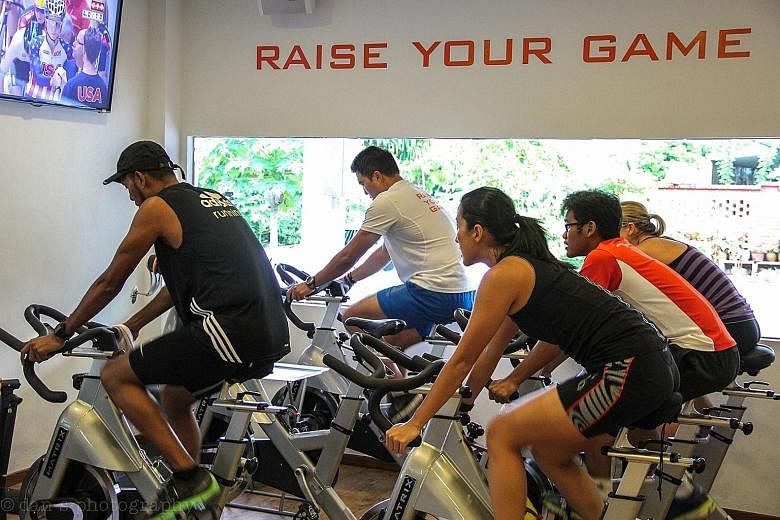Since July, anaesthetist Chin Wui Kin has been going to Altitude Gym four days a week to train in an environment similar to being at a high altitude.
He is chasing his dream of conquering Mount Everest in 2018 and joined the gym to get used to exerting himself at high altitudes.
What he is doing is altitude training. One method is where athletes who live at or near sea level train in low-oxygen environments, similar to environments at high altitudes.
This "live low, train high" concept has become more common.
Altitude Gym, which opened two years ago in Bukit Timah, offers the chance to train in a high-altitude environment, adjustable to a level of between 2,500m and 3,500m.
And later this year, Virgin Active will open a high-altitude training facility in Tanjong Pagar.
Fitness subscription firm GuavaPass also plans to introduce Skinny Rebel, a new workout from Train Dirty in London that aims to mimic the effects of high-altitude training with the use of an altitude mask.
In this kind of training, the body copes with the reduced oxygen by increasing the production of red blood cells, so that the same amount of oxygen can be delivered to the muscles, said Dr Dinesh Sirisena, an associate consultant in sports medicine at Khoo Teck Puat Hospital.
"When you go back to a normal environment, you'll be carrying a higher concentration of oxygen to the muscles."
It takes about three weeks in hypoxic conditions for physiological adaptations, such as a rise in haemoglobin in the blood, to be noticeable. The positive effects may last two weeks or more.
High-altitude training is the legal form of blood doping. Endurance athletes and elite athletes train at high altitudes to enhance their performance instead of injecting themselves with oxygenated blood before an event, which is illegal.
But these athletes are not looking for vast improvements through hypoxic training.
"You're looking at marginal gains. You can challenge people a bit more with hypoxic training but it should be done with things like a healthy lifestyle and a balanced diet," said Dr Sirisena. It will not make a difference if you do not give up smoking or continue to overeat, for instance, he added.
It is all about the small changes, to make an overall bigger impact. For a runner, hypoxic training could make him faster by a few seconds.
Is hypoxic training useful for the average person?
Dr Sirisena is sceptical about this. "Why would the average Joe do this? Maybe if he wants to challenge himself as he's really into his sport."
For instance, when you wear an altitude mask, your breathing will become more shallow and rapid and you will work harder, he said.
Dr Benedict Tan, the sports medicine chief at Changi General Hospital, agrees that hypoxic training is not something for everyone.
He said it is part of the training for athletes to induce the body to adapt to higher levels of performance.
"As the athlete gets fitter, he'd need to step up the training to avoid a plateau," he said. "There comes a point when the usual training is no longer sufficient to induce incremental changes in the fitness level."
Altitude training gives the body that extra jolt.
"For people with a low fitness level, it would be simpler to go on a basic training regimen," said Dr Tan, who chairs Exercise Is Medicine Singapore.
Altitude training may prematurely introduce an unnecessarily high training stimulus and this can discourage a person, he said.
Dr Tan, who has run at 2,800m elevation in Bhutan, said it was difficult to sustain a meaningful running speed. "You'd get breathless even while jogging slowly on a flat course, let alone a hilly course."
Running at a lower elevation of about 1,600m in Colorado was easier. He felt only slightly more breathless than usual and that breathlessness went away after four to seven days.
But Altitude Gym director Brian Angwin, who is an ultra-distance runner, said he trained in a similar gym in Australia and saw "the significant benefits, even for a person of average fitness".
As the environment is around 30 per cent more difficult to train in, you have the option to train harder or spend less time training, he said.
Exercising in a hypoxic environment is likely to cause people to experience more breathing difficulty, compared to at sea level when exercising at the same workload, said Dr Frankie Tan, director of the Singapore Sports Institute.
"However, on a positive note, one may reap the same cardiovascular benefits when exercising at a lower workload, since the stress on the heart and lungs is higher at altitude." Dr Tan said that if a person experiences breathing difficulties or severe headache, he can lower the intensity of exercise or reduce the altitude elevation.
In a hypoxic environment, however, it is difficult to exert oneself fully, so the training intensity may be sub-optimal compared to training intensities at lower altitudes, said Dr Ben Tan.
Hence, many athletes choose to adopt the "sleep high, train low" model, where one sleeps at a high altitude and trains at sea level.
This is what Altitude House at the Singapore Sports Institute, which is set to an altitude of 2,500m, offers elite athletes.


